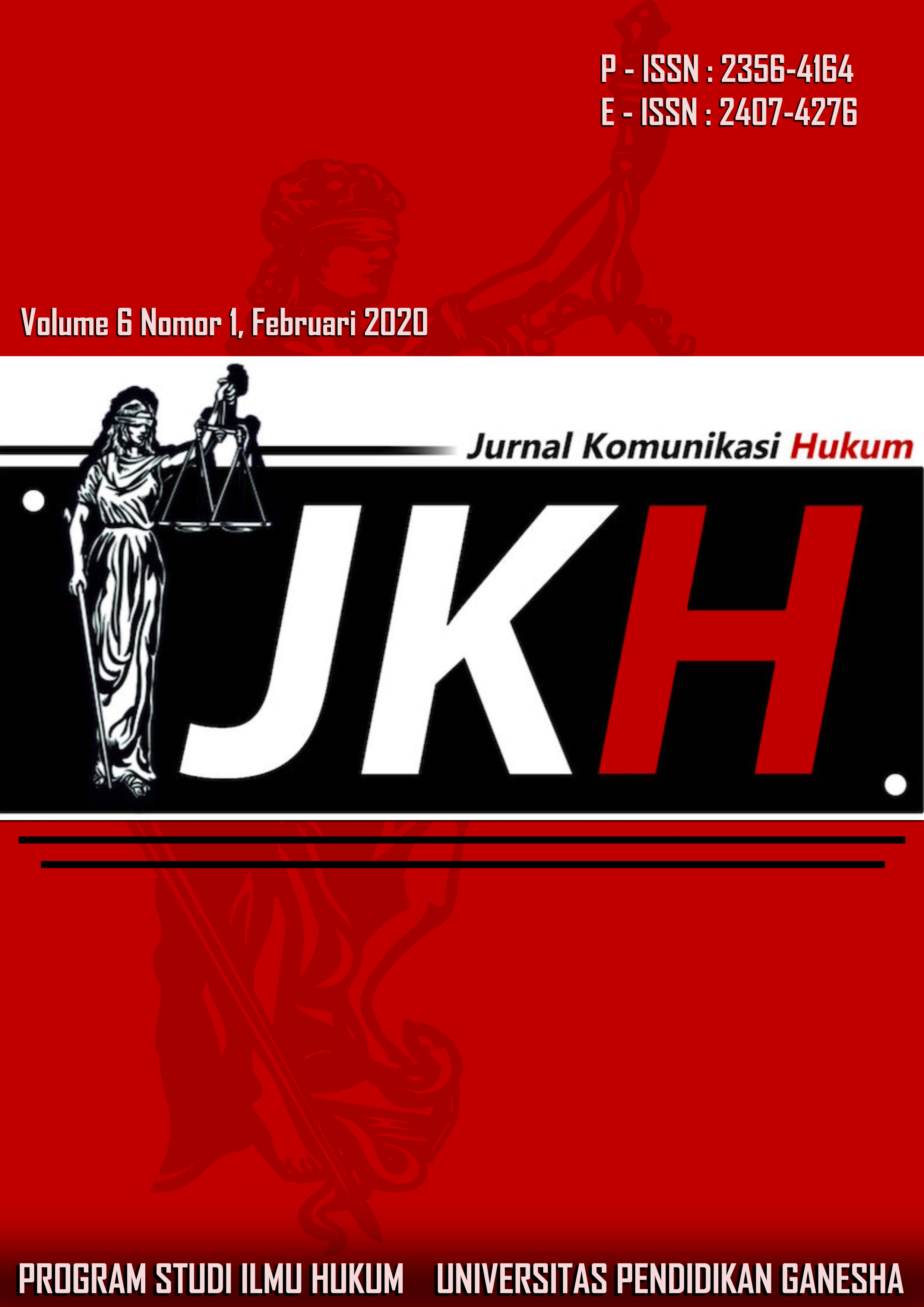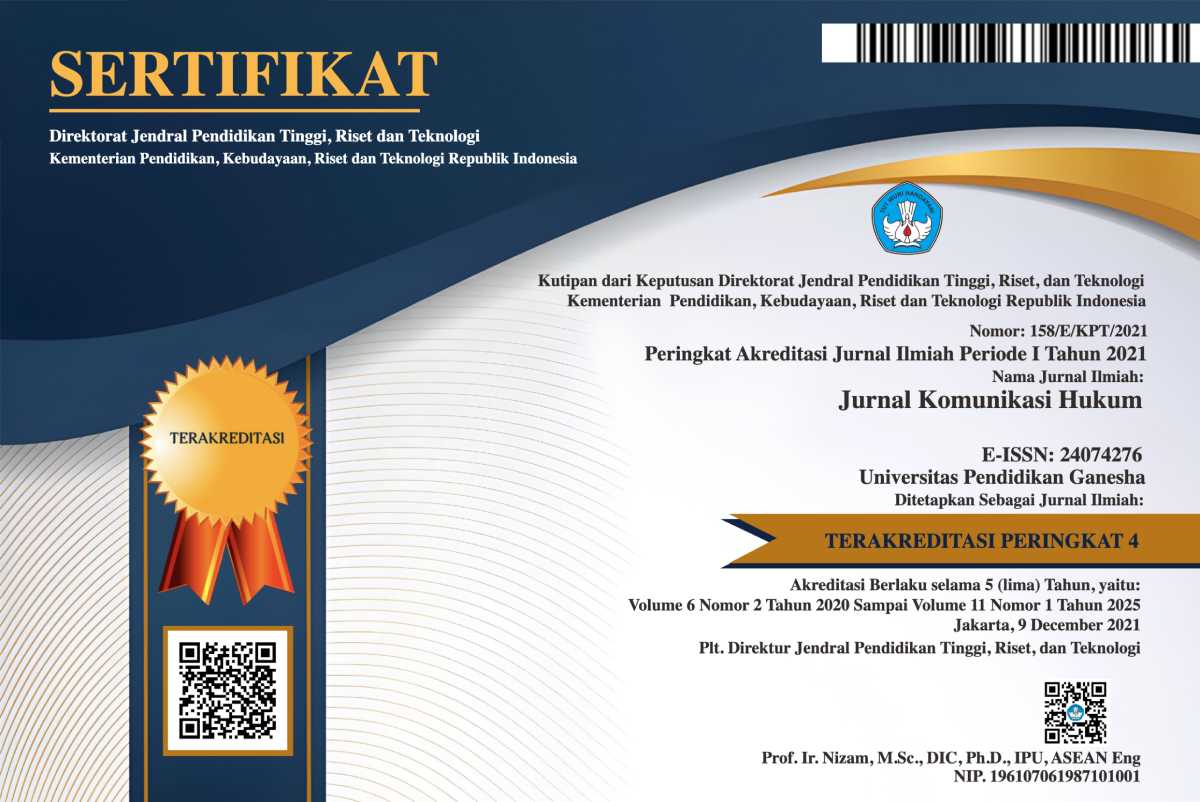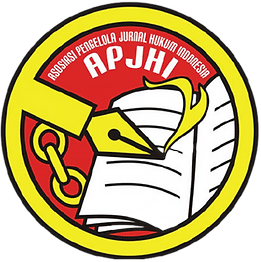PENGGUNAAN BUKTI ELEKTRONIK DALAM PERADILAN PIDANA
DOI:
https://doi.org/10.23887/jkh.v6i1.23607Abstract
Dua hal yang menjadi sasaran dalam kajian ini yaitu: pertama, analisis proses penggunaan informasi/dokumen elektronik sebagai alat bukti dalam peradilan pidana dan, kedua untuk mengkonstruksi parameter dalam penentuan informasi/dokumen elektronik sebagai alat bukti dalam peradilan pidana. Dalam upaya mencapai sasaran tersebut, ditetapkan metode yuridis normatif- empiris dengan pendekatan kasus, konseptual dan perundang-undangan. Kajian ini menggunakan data primer sebagai pokoknya yang dikumpulkan dengan teknik wawancara dan data sekunder yang terdiri dari bahan hukum primer, sekunder dan tersier sebagai tambahan yang dikumpulkan dengan teknik studi dokumen. Kumpulan data selanjutnya diolah dengan cara diseleksi, diklasifikasi dan disistematisasi yang kemudian dianalisis secara kualitatif melalui penyajian deskriptif-preskriptif. Proses tersebut dilaksanakan secara menyeluruh dengan mengkontekskan secara logis berdasarkan relevansinya dengan topik penelitian yang diangkat. Diujung penelitian ini diperoleh hasil dan kesimpulan bahwa prinsipnya hakim menentukan informasi/dokumen elektronik sebagai alat bukti dalam peradilan pidana melalui tiga langkah. Pertama, memastikan legalitas perolehan informasi/dokumen elektronik. Kedua, mengecek dokumen pendukung yang berupa hasil uji digital forensik. Ketiga, memberikan kesempatan bagi pihak lawan melakukan penyangkalan yang tentu dibarengi pembuktian akan dalilnya. Sementara, parameter yang digunakan hakim sampai pada informasi/dokumen elektronik dipertimbangkan dalam putusannya adalah dapat diakses; ditampilkan; dijamin keutuhannya; dan dipertanggungjawabkan.
Kata kunci: bukti elektronik, pembuktian, peradilan pidana.
Downloads
Published
How to Cite
Issue
Section
License
Authors who publish with this journal agree to the following terms:- Authors retain copyright and grant the journal right of first publication with the work simultaneously licensed under a Creative Commons Attribution License that allows others to share the work with an acknowledgement of the work's authorship and initial publication in this journal.
- Authors are able to enter into separate, additional contractual arrangements for the non-exclusive distribution of the journal's published version of the work (e.g., post it to an institutional repository or publish it in a book), with an acknowledgement of its initial publication in this journal.
- Authors are permitted and encouraged to post their work online (e.g., in institutional repositories or on their website) prior to and during the submission process, as it can lead to productive exchanges, as well as earlier and greater citation of published work (See The Effect of Open Access).
Authors who publish with this journal agree to the following terms:
- Authors retain copyright and grant the journal right of first publication, with the work [SPECIFY PERIOD OF TIME] after publication simultaneously licensed under aCreative Commons Attribution License that allows others to share the work with an acknowledgement of the work's authorship and initial publication in this journal.
- Authors are able to enter into separate, additional contractual arrangements for the non-exclusive distribution of the journal's published version of the work (e.g., post it to an institutional repository or publish it in a book), with an acknowledgement of its initial publication in this journal.
- Authors are permitted and encouraged to post their work online (e.g., in institutional repositories or on their website) prior to and during the submission process, as it can lead to productive exchanges, as well as earlier and greater citation of published work (See The Effect of Open Access).












